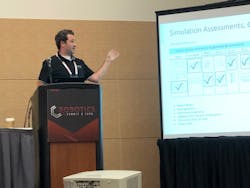Otto Motors is a maker of autonomous mobile robots (AMRs) used to automate material handling in manufacturing and warehouse operations. The robots are designed to bring materials to and from people, equipment, racks, and shelving in a free-movement manner. With collaborative capabilities built-in, AMRs are a highly productive way to optimize workflows.
According to the company, Otto robots have the ability to double productivity, but they have to be installed correctly in the first place. Simply using a spreadsheet to figure out how many AMRs are needed in an operation comes with a cost if there are too few—or too many—robots. Even a 20% variable on a fleet of 100 AMR vehicles means that either a customer is not getting what they need or are spending more than they should to achieve what is necessary, which makes for a weaker ROI.
But there’s a solution to this problem, and it comes in the form of simulation software.
Matthew Rendall, CEO and co-founder of Otto Motors, was at the Robotics Summit & Expo in Boston in May delivering a presentation on the use of simulation for successful AMR deployments.
“We believe simulation is a critical prerequisite in your toolkit for a large fleet implementation,” Rendall said. “And the reason is that you can be highly granular, highly variable, and very catered to the specifics of not only the layout of the facility, but how your operation changes day by day, shift by shift, and minute by minute. And then you can load all of those parameters into a simulation and model it for a full operation.”
It's basically a way to start with the end in mind and mitigate the risk of failure via scenario analysis. The larger the fleet, the bigger the risk. “If you have 100 AMRs on a line, you are probably integrated into mission critical business processes, “Rendall explained. “And if that system doesn’t work the plant doesn’t work, and if the plant doesn’t work that is catastrophic. So simulation is important for risk mitigation.”
Rendall went on to describe two real customer scenarios, one greenfield deployment and one brownfield. They have some similarities, but in a greenfield project—where you are not dealing with existing infrastructure—the benefits of operational efficiency are very high.
AMR Simulation in Action
The greenfield site was a 1 million sq. ft. facility covering production and warehousing. It had 300 pickup/dropoff locations and AMRs would do 5,000 deliveries and cover over 1,000 miles per day. Because they were starting from scratch, Otto was able to partner with the customer to help them rethink how their manufacturing facility of the future would be laid out. Then they could simulate scenarios testing for routing, traffic, location, etc.
The simulation is split into two categories, physics simulation and process simulation, with the output of the physics simulation used as an input into the process simulation. Here is where the fun stuff happens.
“We put the robots into the matrix,” Rendall said. “They don’t know they’re in a simulation as the software is fully emulating the environment. So we teleport the vehicle into the matrix and it’s operating with no knowledge it’s in a simulated environment versus a real environment.”
From there, they can conduct micro-tests to look at interactions and understand how much time an AMR will spend waiting at intersections and pickup locations, for example. These things are validated in the real world and feedback is created in a closed loop micro-simulation to ultimately look at the entire end-to-end process to see how the operation unfolds.
In this case, the manufacturer actually reduced the number of AMRs needed while increasing efficiencies simply by being able to work through each scenario analysis. “It was originally scoped at 102 AMRs, but with the simulation we were able to optimize the design to 83 AMRs,” Rendall explained. So while some customers might balk at the thought of spending more upfront on simulation software, there’s real value on the other side. “Invest a little up front in simulation and save 20% of your fleet size through smarter design and more confidence.”
Brownfield simulations have a similar approach, with the fundamental difference being lower degrees of freedom based on decisions that have been happening for however old the facility has been in existence. It is also often dealing with a mix of traffic including forklifts, AMRs, and people. So the approach here is more about how to phase in AMRs without disruption to the operation to minimize downtime.
In either scenario, however, the use of simulation results in the same outcome. “Our position is that a small amount of investment upfront is so important in order to set the project up for success and to make sure you are spending the right amount of money to solve the right problems and mitigate the execution risk associated with going live with an AMR implementation,” Rendall said.
Leaders relevant to this article:

